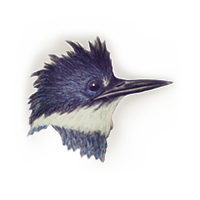|
Field
Guide IDs: BREEDING:
Usu along
watercourses, both freshwater and marine. 1
brood. DISPLAYS:
Prolonged rapid
succession of mewing calls. NEST:
Horizontal (or
slightly upward-sloping) burrow in vertical bank
near water; prefer soil with high sand, low clay
composition. Male and female alternately dig and
remove detritus. Usu 3'-6', may reach 15' in
length. Nest chamber holds grass or leaf saucer.
Occ in tree cavity. EGGS:
White. 1.4" (34
mm). DIET:
Occ also takes
aquatic invertebrates, amphibians, reptiles,
insects, young birds, mice; rarely berries. Also
oysters and squid on coast. Young fed regurgitant.
Ejects pellets. Dives from perch or hovers and
dives from above. CONSERVATION:
Winters s to n
S.A. NOTES:
Nestlings cling
together and can maintain body heat in a group at 6
days, whereas lone nestling requires 16 days. Mates
can recognize each other by distinctive calls given
when approaching nest. After fledging, parents
teach fishing to perched young by dropping dead
meals into water for retrieval; at 10 days
postfledging, young catch live food and are forced
from parental territory. Fish fills throat while
rapid digestion allows it to inch down gullet.
Solitary when not breeding, defends individual
feeding territories, size inversely correlated with
food abundance. Fairly rare visitor
to Lagunita, breeding more regularly along streams
nearby (e.g., San Francisquito Creek). ESSAYS: Birds
and the Law;
Swimming;
Vocal
Functions;
Pellets;
Temperature
Regulation;
Territoriality;
Parental
Care. REFERENCES:
Brooks and Davis,
1987; Davis, 1982, 1986. |
